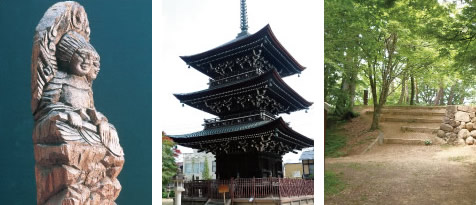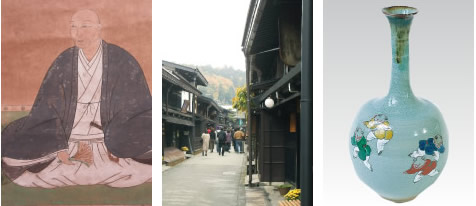History
History of Takayama

Takayama City lies roughly in the middle of the Japanese Islands with 3,000-meter-high mountains surrounding it. The people who live in the area have always co-existed and have had a deep relationship with the mountains. Therefore, they have extensive knowledge about the mountains and the plants which grow there. In the tax rules from 1,300 years ago, there is one which stipulated that people living in the Hida region were exempt from paying a jintozei tax -a tax imposed on every citizen regardless of their ability to pay. They were not allowed to pay the tax with specialty crops either, but they were instead required to do woodworking in Nara/Kyoto. This special rule only applied to Hida people. There are various views regarding the reason, but it is most likely that the knowledge and skills the people in the region had was highly sought after. About 500 years ago, if someone was called "Hida no Takumi," he was considered to be a great woodworker; and this image became widespread. Furthermore, in some rakugo (comic storytelling) and ukiyoe (woodblock prints), "Hida no Takumi" people are described as highly-skilled woodworkers. However, most of the forests in Hida were chopped down in the 17th century and had already been depleted. In Hida, which was under the direct control of the Edo Shogunate (the central government from the 16th to the 19th centuries), a reforestation policy was implemented from a relatively early stage in the first half of the 18th Century. The spirits of "Hida no Takumi" and "knowing the trees and bringing out the characteristics of the wood" were inherited by the Hida people.

Until the Edo Shogunate (the Central Government) began direct control in 1692, Hida was ruled by a daimyo named Nagachika Kanamori beginning in 1585. Kanamori built his castle in the current location of Shiroyama Park right in the middle of Hida and created a town around it for samurai warriors and merchants. The town was surrounded by two rivers: Enakogawa River and Miyagawa River. Religious establishments, such as temples and shrines, were placed nearby; and the foundation of the town was formed. With four main roads ("kaido")-Ecchu Kaido from the north, Owari Kaido from the south, Hirayu Kaido from the east and Gojo-Shirakawa Kaido from the west-converging at Takayama, the town has a history of prospering as a commercial town. The direct ruling by the Edo Shogunate (the Central Government) lasted for 177 years since 1962, but this shogunate of more than 260 years fell due to the Meiji Revolution. It was also the end of the 700-year-long era of the samurai. Takayama Town, which later became Takayama City, was established in 1875. After a merger of the towns and villages, Takayama Town became Takayama City in 1936. In 2005, the city merged with nine surrounding towns and villages and became the largest city in Japan. The city covers an area larger than Tokyo.
The history of Takayama can also be seen in the streets lined with historical and distinctive houses. Traditional houses in Japan are mainly made with wood, earth and paper. Particularly in Takayama, the temperature in the winter is extremely low, and terracotta tiles are not suitable for the roofs. Therefore, split timbers layered at a gentle angle were used to thatch roofs. However, these roofs were highly combustible. So once a fire occurred, it spread to the nearby houses and quite often became a disastrous fire. With the development of fire fighting technology, the number of large fires decreased around the end of the 19th century; and the traditional houses in Takayama are still standing today. Also, the ceilings of these traditional houses are low. There were two reasons for this: one is that builders were unable to make the houses taller because they were wooden, and the other is that people lit fires inside the houses to keep them warm during the winter and smaller houses retain heat better. In addition, when people wanted to build a new house, they needed to seek permission from their neighbors. Therefore, they were unable to build more elaborate houses which would not match the others. The very orderly streets we can see today were created over a long period of time and with great effort from local residents.
